tags: Birdbooker Report, bird books, animal books, natural history books, ecology books
Books to the ceiling,
Books to the sky,
My pile of books is a mile high.
How I love them! How I need them!
I'll have a long beard by the time I read them.
~ Arnold Lobel [1933-1987] author of many popular children's books.
The Birdbooker Report is a special weekly report of a wide variety of science, nature, environment and behavior books and field guides that currently are, or soon will be available for purchase. This report is written by one of my Seattle birding pals and book collector, Ian "Birdbooker" Paulsen, and is edited by me and published here for your information and enjoyment. Below the fold is this week's issue of The Birdbooker Report which lists ecology, environment, natural history and bird books that are (or will soon be) available for purchase.
FEATURED TITLE:
-
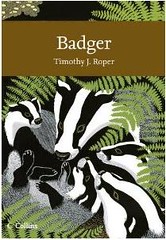 Roper, Timothy J. Badger. 2010. Collins UK. Paperback: 386 pages. Price: $50.00 U.S. [Amazon: $31.50].
Roper, Timothy J. Badger. 2010. Collins UK. Paperback: 386 pages. Price: $50.00 U.S. [Amazon: $31.50].
SUMMARY: The Eurasian badger (Meles meles) has for many years occupied a unique place in the British consciousness. Despite the fact that most people have never seen one, the badger has become one of Britain's best-loved animals. The number of organisations that use the badger as a logo, the number of websites featuring information about badgers, and the number of voluntary badger protection societies that exist are testament to this popularity. In fact, the attitude of most ordinary people towards badgers is complex and contradictory, involving a combination of familiarity and ignorance, concern and indifference. For an increasing number of people, badgers constitute an important source of interest and pleasure, be it through watching them in their gardens or in the wild, sharing badger-related knowledge and experiences with others via the internet, or defending badgers against threats to their welfare. For others, on the other hand, badgers are a problem species that requires active management. In this highly anticipated new study, Prof Tim Roper explores every aspect of the biology and behavior of these fascinating animals. In doing so, he reveals the complexities of a lifestyle that allows badgers to build communities in an astonishing variety of habitats, ranging from pristine forests to city centers. He also reveals the facts behind the controversy surrounding the badgers' role in transmitting tuberculosis to cattle, shedding new light on an issue that has resulted in one of the most extensive wildlife research programs ever carried out.
RECOMMENDATION: A detailed monograph on the species that will appeal to mammalogists and naturalists.
New and Recent Titles:
-
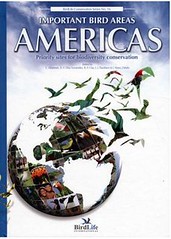 Devenish, Christian et al. (editors). Important Bird Areas Americas: Priority sites for Biodiversity conservation. 2010. Birdlife International. Hardbound: 456 pages. Price: $66.00 U.S. [NHBS Price: £44.99].
Devenish, Christian et al. (editors). Important Bird Areas Americas: Priority sites for Biodiversity conservation. 2010. Birdlife International. Hardbound: 456 pages. Price: $66.00 U.S. [NHBS Price: £44.99].
SUMMARY: This directory provides a concise summary of the 2345 Important Bird Areas described to date in the Americas. The inventory represents a participative consensus on the most important sites for bird and biodiversity conservation in the hemisphere, in what is probably the most comprehensive assessment of its kind to be published. Since the beginning of the IBA program in North America in 1995, sites have now been identified in all 57 countries or territories in the region, totaling more than 3,250,000 km2. This book is the culmination of national IBA identification processes involving thousands of people in the Caribbean, North, Central and South America, and at least 150 governmental and non-governmental organizations. The directory is at once a high level awareness-raising publication; a decision-making tool for national and hemispheric biodiversity management and planning; and a portfolio of funding opportunities for potential donors.
RECOMMENDATION: A very useful and well illustrated guide to North and South American bird conservation. -
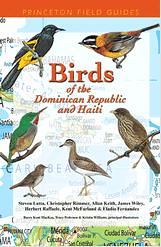 Latta, Steven et al. Birds of the Dominican Republic and Haiti. 2006. Princeton University Press. Paperback: 258 pages. Price: $35.00 U.S. [Amazon: $25.55].
Latta, Steven et al. Birds of the Dominican Republic and Haiti. 2006. Princeton University Press. Paperback: 258 pages. Price: $35.00 U.S. [Amazon: $25.55].
SUMMARY: Birds of the Dominican Republic and Haiti fills a large void in the literature on birdwatching and the environment in these tropical countries. The first comprehensive field guide devoted to Hispaniola's birds, it provides detailed accounts for more than 300 species, including thirty-one endemic species. Included in the species descriptions are details on key field marks, similar species, voice, habitats, geographic distribution on Hispaniola, status, nesting, range, and local names used in both the Dominican Republic and Haiti. The authors also comment on ecology, behavior, and taxonomic status. The book provides color illustrations and range maps based on the most recent data available. But the authors' intent is to provide more than just a means of identifying birds. The guide also underscores the importance of promoting the conservation of migratory and resident birds, and building support for environmental measures. Information about an Iphone app where all proceeds go to disaster relief. The Spanish version is available through Buteo Books.
RECOMMENDATION: For birders with an interest in neotropical birds. -
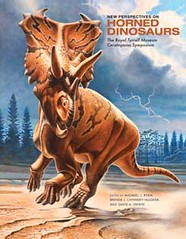 Ryan, Michael J., Brenda J. Chinnery-Allgeier, and David A. Eberth (editors). New Perspectives on Horned Dinosaurs. 2010. Indiana University Press. Hardbound: 624 pages. Price: $110.00 U.S. [Amazon: $74.25].
Ryan, Michael J., Brenda J. Chinnery-Allgeier, and David A. Eberth (editors). New Perspectives on Horned Dinosaurs. 2010. Indiana University Press. Hardbound: 624 pages. Price: $110.00 U.S. [Amazon: $74.25].
SUMMARY: Easily distinguished by the horns and frills on their skulls, ceratopsids were one of the most successful of all dinosaurs. This volume presents a broad range of cutting-edge research on the functional biology, behavior, systematics, paleoecology, and paleogeography of the horned dinosaurs, and includes descriptions of newly identified species. This title includes 310 black-and-white illustrations and a supplemental CD-ROM.
RECOMMENDATION: For those with a technical interest in ceratopsids. -
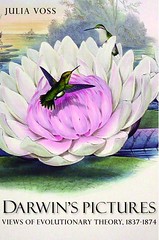 Voss, Julia. Darwin's Pictures: Views of Evolutionary Theory, 1837-1874. 2010. Yale University Press. Hardbound: 340 pages. Price: $45.00 U.S. [Amazon: $32.40].
Voss, Julia. Darwin's Pictures: Views of Evolutionary Theory, 1837-1874. 2010. Yale University Press. Hardbound: 340 pages. Price: $45.00 U.S. [Amazon: $32.40].
SUMMARY: In this first-ever examination of Charles Darwin's sketches, drawings, and illustrations, Julia Voss presents the history of evolutionary theory told in pictures. Darwin had a life-long interest in pictorial representations of nature, sketching out his evolutionary theory and related ideas for over forty years. Voss details the pictorial history of Darwin's theory of evolution, starting with his notebook sketches of 1837 and ending with the illustrations in The Expression of Emotions in Man and Animals (1872). These images were profoundly significant for Darwin's long-term argument for evolutionary theory; each characterizes a different aspect of his relationship with the visual information and constitutes what can be called an "icon" of evolution. Voss shows how Darwin "thought with his eyes" and how his pictorial representations and the development and popularization of the theory of evolution were vitally interconnected.Voss explores four of Darwin's images in depth, and weaves about them a story on the development and presentation of Darwin's theory, in which she also addresses the history of Victorian illustration, the role of images in science, the technologies of production, and the relationship between specimen, words, and images.
RECOMMENDATION: For those with an interest in the history of evolution. -
 Jonaitis, Aldona and Aaron Glass. The Totem Pole: An Intercultural History. 2010. University of Washington Press. Hardbound: 331 pages. Price: $50.00 U.S. [Amazon: $31.50].
Jonaitis, Aldona and Aaron Glass. The Totem Pole: An Intercultural History. 2010. University of Washington Press. Hardbound: 331 pages. Price: $50.00 U.S. [Amazon: $31.50].
SUMMARY: The Northwest Coast totem pole captivates the imagination. From the first descriptions of these tall carved monuments, totem poles have become central icons of the Northwest Coast region and symbols of its Native inhabitants. Although many of those who gaze at these carvings assume that they are ancient artifacts, the so-called totem pole is a relatively recent artistic development, one that has become immensely important to Northwest Coast people and has simultaneously gained a common place in popular culture from fashion to the funny pages. The Totem Pole reconstructs the intercultural history of the art form in its myriad manifestations from the eighteenth century to the present. Aldona Jonaitis and Aaron Glass analyze the totem pole's continual transformation since Europeans first arrived on the scene, investigate its various functions in different contexts, and address the significant influence of colonialism on the proliferation and distribution of carved poles. The authors also describe their theories on the development of the art form: its spread from the Northwest Coast to world's fairs and global theme parks; its integration with the history of tourism and its transformation into a signifier of place; the role of governments, museums, and anthropologists in collecting and restoring poles; and the part that these carvings have continuously played in Native struggles for control of their cultures and their lands.
RECOMMENDATION: For anyone interested in Native American art.
You can read all the Birdbooker Reports in the archives on this site, and Ian now has his own website, The Birdbooker Report, where you can read his synopses about newly published science, nature and animal books. But Ian assures me that he still loves us here, so he'll still share his weekly Birdbooker Reports with us!
- Log in to post comments


... each ... constitutes what can be called an "icon" of evolution.
They could only be called that with a written license from Jonathan Wells and the attorneys of the Unification Church, thankyouverymuch.